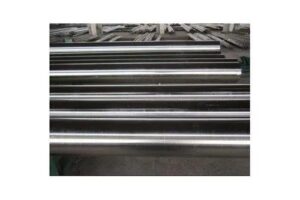316LN UNS S31653 Austenitic Stainless Steel
SPECIFICATION COVERAGE
316LN alloy is included in ASTM A 240 for plate, sheet, and strip
ASTM A479/A479M-2015 Standard Specification for Stainless Steel Bars and Shapes for Use in Boilers and Other Pressure Vessels
COMPOSITION
| Element | Minimum | Maximum |
| Chromium | 16 | 18 |
| Molybdenum | 2 | 3 |
| Nickel | 10 | 14 |
| Manganese | 2 | |
| Phosphorus | 0.045 | |
| Sulfur | 0.03 | |
| Silicon | 0.75 | |
| Carbon | 0.03 | |
| Nitrogen | 0.1 | 0.16 |
| Iron | balance | |
MECHANICAL PROPERTIES
Typical Room Temperature properties
| Property | ASTM A 240 |
| Yield Strength, 0.2% offset | 30 ksi |
| 205 MPa | |
| Ultimate Tensile Strength | 75 ksi |
| 515 MPa | |
| Elongation in 2″ (51 mm) | 40% |
| Hardness | 217 Brinell |
| 95 HRB |
GENERAL PROPERTIES
316LN (UNS S31653) stainless is a low-carbon, nitrogen-enhanced version of Type 316 molybdenum-bearing austenitic stainless steel. It is also known as DIN/EN designation No. 1.4406. The Type 316 alloys are more resistant to general corrosion and pitting/crevice corrosion than the conventional chromium-nickel austenitic stainless steels such as Type 304. They also offer higher creep, stress-rupture and tensile strength at elevated temperature. 316 stainless steel can be susceptible to sensitization the formation of grain boundary chromium carbides at temperatures between approximately 900 and 1500 F (425 to 815 C) which can result in rapid corrosion. Reduced carbon 316L alloy is resistant to sensitization; however, extended exposures in this temperature range will eventually result in sensitization of even the low carbon grade.
The nitrogen in 316LN alloy adds additional resistance to sensitization in some circumstances. The nitrogen content of 316LN stainless steel also provides some solid solution hardening, raising its minimum specified yield strength compared to 316L stainless steel. Like 316 and 316L alloys, the 316LN alloy also offers excellent resistance to general corrosion and pitting/crevice corrosion.
Fatigue Resistance
The fatigue strength or endurance limit is the maximum stress below which a material is unlikely to fail in 10 million cycles in an air environment. For austenitic stainless steels as a group, the fatigue strength is typically about 35 percent of the tensile strength.
However, substantial variability in service results is experienced since additional variables such as corrosive conditions, type of loading and mean stress, surface condition, and other factors affect fatigue properties. For this reason, no definitive endurance limit value can be given which is representative of all operating conditions.
Fabrication
The austenitic stainless steels, including the 316LN alloy, are routinely fabricated into a variety of shapes ranging from the very simple to very complex. These alloys are blanked, pierced, and formed on equipment essentially the same as used for carbon steel. The excellent ductility of the austenitic alloys allows them to be readily formed by bending, stretching, deep drawing and spinning. However, because of their greater strength and work hardenability, the power requirements for the austenitic grades during forming operations are considerably greater than for carbon steels. Attention to lubrication during forming of the austenitic alloys is essential to accommodate the high strength and galling tendency of these alloys.
Annealing
The austenitic stainless steels are provided in the mill-annealed condition ready for use. Heat treatment may be necessary during or after fabrication to remove the effects of cold forming or to dissolve precipitated chromium carbides resulting from thermal exposures. For the 316LN alloy the solution anneal is accomplished by heating in the 1900- 2150F (1040-1175C) temperature range followed by air cooling or a water quench, depending on section thickness. 316LN stainless cannot be hardened by heat treatment.
Welding
The austenitic stainless steels are considered the most weldable of the stainless steels. They are routinely joined by all fusion and resistance welding processes. Two important considerations for weld joints in these alloys are avoidance of solidification cracking, and preservation of corrosion resistance of the weld and heat-affected zones. 316LN stainless steel often is welded autogenously. If filler metal must be used for welding 316LN stainless, it is advisable to utilize the low carbon 316L. Contamination of the weld region with copper or zinc should be avoided, since these elements can form low melting point compounds, which in turn can create weld cracking.

